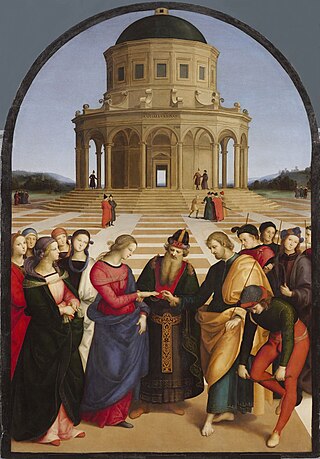
Annibale Carracci was an Italian painter and instructor, active in Bologna and later in Rome. Along with his brother and cousin, Annibale was one of the progenitors, if not founders of a leading strand of the Baroque style, borrowing from styles from both north and south of their native city, and aspiring for a return to classical monumentality, but adding a more vital dynamism. Painters working under Annibale at the gallery of the Palazzo Farnese would be highly influential in Roman painting for decades.

Piero della Francesca was an Italian painter, mathematician and geometer of the Early Renaissance, nowadays chiefly appreciated for his art. His painting is characterized by its serene humanism, its use of geometric forms and perspective. His most famous work is the cycle of frescoes The History of the True Cross in the Basilica of San Francesco in the Tuscan town of Arezzo.

Andrea del Verrocchio was an Italian sculptor, painter and goldsmith who was a master of an important workshop in Florence.

Renaissance art is the painting, sculpture, and decorative arts of the period of European history known as the Renaissance, which emerged as a distinct style in Italy in about AD 1400, in parallel with developments which occurred in philosophy, literature, music, science, and technology. Renaissance art took as its foundation the art of Classical antiquity, perceived as the noblest of ancient traditions, but transformed that tradition by absorbing recent developments in the art of Northern Europe and by applying contemporary scientific knowledge. Along with Renaissance humanist philosophy, it spread throughout Europe, affecting both artists and their patrons with the development of new techniques and new artistic sensibilities. For art historians, Renaissance art marks the transition of Europe from the medieval period to the Early Modern age.

Museo di Capodimonte is an art museum located in the Palace of Capodimonte, a grand Bourbon palazzo in Naples, Italy designed by Giovanni Antonio Medrano. The museum is the prime repository of Neapolitan painting and decorative art, with several important works from other Italian schools of painting, and some important ancient Roman sculptures. It is one of the largest museums in Italy. The museum was inaugurated in 1957.

The Pinacoteca di Brera is the main public gallery for paintings in Milan, Italy. It contains one of the foremost collections of Italian paintings from the 13th to the 20th century, an outgrowth of the cultural program of the Brera Academy, which shares the site in the Palazzo Brera.

The Assumption of the Virgin Mary does not appear in the New Testament, but appears in apocryphal literature of the 3rd and 4th centuries, and by 1000 was widely believed in the Western Church, though not made formal Catholic dogma until 1950. It first became a popular subject in Western Christian art in the 12th century, along with other narrative scenes from the Life of the Virgin, and the Coronation of the Virgin. These "Marian" subjects were especially promoted by the Cistercian Order and Saint Bernard of Clairvaux.

Giovanni Santi was an Italian painter and decorator, father of Raphael Sanzio. He was born in 1435 at Colbordolo in the Duchy of Urbino. He studied under Piero della Francesca and was influenced by Fiorenzo di Lorenzo. He was court painter to the Duke of Urbino and painted several altarpieces among other things. He died in Urbino.

Italian Renaissance painting is the painting of the period beginning in the late 13th century and flourishing from the early 15th to late 16th centuries, occurring in the Italian Peninsula, which was at that time divided into many political states, some independent but others controlled by external powers. The painters of Renaissance Italy, although often attached to particular courts and with loyalties to particular towns, nonetheless wandered the length and breadth of Italy, often occupying a diplomatic status and disseminating artistic and philosophical ideas.
The decade of the 1490s in art involved some significant events.
The decade of the 1460s in art involved some significant events.
The decade of the 1440s in art involved some significant events.

This article about the development of themes in Italian Renaissance painting is an extension to the article Italian Renaissance painting, for which it provides additional pictures with commentary. The works encompassed are from Giotto in the early 14th century to Michelangelo's Last Judgement of the 1530s.

The National Gallery is the primary British national public art gallery, sited on Trafalgar Square, in central London. It is home to one of the world's greatest collections of Western European paintings. Founded in 1824, from an initial purchase of 36 paintings by the British Government, its collections have since grown to about 2,300 paintings by roughly 750 artists dating from the mid-13th century to 1900, most of which are on display. This page lists some of the highlights of the collection.
The Pietà is a subject in Christian art depicting the Virgin Mary cradling the dead body of Jesus.

The National Art Gallery of Bologna is a museum in Bologna, Italy. It is located in the former Saint Ignatius Jesuit novitiate of the city's University district, and inside the same building that houses the Academy of Fine Arts. The museum offers a wide collection of Emilian paintings from the 13th to the 18th century and other fundamental works by artists who were in some way related to the city.
Tobias and the Angel is a subject in art taken from the Book of Tobit. It may refer to a number of works of art and music, including:

The Baptism of Christ is a painting by Annibale Carracci.
The Madonna and Child with Saints are the subject of several artworks.












